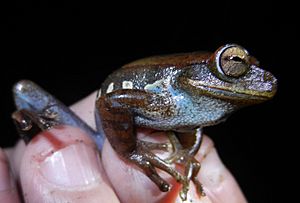Cusco gladiator tree frog facts for kids
Quick facts for kids Cusco gladiator tree frog |
|
|---|---|
 |
|
| Conservation status | |
| Scientific classification | |
| Synonyms | |
|
The Cusco gladiator tree frog (scientific name: Boana gladiator) is a unique type of frog. It belongs to the Hylidae family, which includes many tree frogs. This frog lives only in Peru, specifically in the areas of Cusco and Puno.
Scientists have found these frogs living high up in the mountains. They are usually seen between 1,097 and 1,975 meters (about 3,600 to 6,480 feet) above sea level. These frogs prefer to live in cool, moist places called cloud forests. Cloud forests are misty forests found in tropical mountains.
Contents
About the Cusco Gladiator Tree Frog
What Does It Look Like?
Adult male Cusco gladiator tree frogs are usually between 35.3 and 49.4 millimeters long. This measurement is taken from their snout (nose) to their vent (bottom). Female frogs are a bit larger. They measure from 47.8 to 55.3 millimeters long.
One very interesting feature of the male Cusco gladiator tree frog is a small spike. Each male frog has a spike on each of its front feet. These spikes are not just for show. Male frogs use them to fight other males. This helps them compete for mates or territory.
Where Do They Lay Eggs?
Female Cusco gladiator tree frogs lay their eggs in streams. This is a common behavior for many frog species. The young tadpoles then grow and develop in the water before becoming adult frogs.
Why Is This Frog in Danger?
The Cusco gladiator tree frog is currently listed as vulnerable to extinction. This means that without help, it could disappear forever. There are a few main reasons why this frog is in danger.
Habitat Loss
One of the biggest threats to the Cusco gladiator tree frog is habitat loss. This happens when the places where the frogs live are destroyed or changed. Forests might be cut down for farming or building. This leaves the frogs with fewer places to live, find food, and lay eggs.
Chytrid Fungus
Another serious threat is a disease called chytridiomycosis. This illness is caused by a tiny fungus called Batrachochytrium dendrobatidis. This fungus is very dangerous for frogs and other amphibians.
When a frog gets chytridiomycosis, the fungus attacks its skin. The frog's skin becomes thick and can even start to peel off. This is a big problem because frogs use their skin to breathe and to control the amount of water and salts in their bodies. This process is called osmoregulation.
When the skin is damaged, the frog cannot osmoregulate properly. The important salts, called electrolytes, in the frog's blood drop to very low levels. This can make the frog's heart stop working, leading to its death. Scientists are working hard to understand and fight this deadly fungus.
See also
In Spanish: Hypsiboas gladiator para niños


